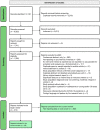The duration of intervals on the oral cancer care pathway and implications for survival: a systematic review and meta-analysis
- PMID: 37614446
- PMCID: PMC10442570
- DOI: 10.3389/fpubh.2023.1183244
The duration of intervals on the oral cancer care pathway and implications for survival: a systematic review and meta-analysis
Abstract
Introduction: Previous studies measuring intervals on the oral cancer care pathway have been heterogenous, showing mixed results with regard to patient outcomes. The aims of this research were (1) to calculate pooled meta-analytic estimates for the duration of the patient, diagnostic and treatment intervals in oral cancer, considering the income level of the country, and (2) to review the evidence on the relationship of these three intervals with tumor stage at diagnosis and survival.
Materials and methods: We conducted a systematic review with meta-analysis following PRISMA 2020 guidelines (pre-registered protocol CRD42020200752). Following the Aarhus statement, studies were eligible if they reported data on the length of the patient (first symptom to first presentation to a healthcare professional), diagnostic (first presentation to diagnosis), or treatment (diagnosis to start of treatment) intervals in adult patients diagnosed with primary oral cancer. The risk of bias was assessed with the Aarhus checklist.
Results: Twenty-eight studies reporting on 30,845 patients met the inclusion criteria. The pooled median duration of the patient interval was 47 days (95% CI = 31-73), k = 18, of the diagnosis interval 35 days (95% CI = 21-38), k = 11, and of the treatment interval 30 days (95% CI = 23-53), k = 19. In lower-income countries, the patient and treatment intervals were significantly longer, and longer patient intervals were related to later stage at diagnosis. In studies with a lower risk of bias from high-income countries, longer treatment intervals were associated with lower survival rates.
Conclusion: Interval duration on the oral cancer care pathway is influenced by the socio-economic context and may have implications for patient outcomes.
Keywords: TNM staging; early diagnosis; intervals; oral cancer; survival.
Copyright © 2023 Fernández-Martínez, Petrova, Špacírová, Barrios-Rodríguez, Pérez-Sayáns, Martín-delosReyes, Pérez-Gómez, Rodríguez-Barranco and Sánchez.
Conflict of interest statement
The authors declare that the research was conducted in the absence of any commercial or financial relationships that could be construed as a potential conflict of interest.
Figures


Similar articles
-
Intravenous magnesium sulphate and sotalol for prevention of atrial fibrillation after coronary artery bypass surgery: a systematic review and economic evaluation.Health Technol Assess. 2008 Jun;12(28):iii-iv, ix-95. doi: 10.3310/hta12280. Health Technol Assess. 2008. PMID: 18547499
-
Signs and symptoms to determine if a patient presenting in primary care or hospital outpatient settings has COVID-19.Cochrane Database Syst Rev. 2022 May 20;5(5):CD013665. doi: 10.1002/14651858.CD013665.pub3. Cochrane Database Syst Rev. 2022. PMID: 35593186 Free PMC article.
-
Systemic pharmacological treatments for chronic plaque psoriasis: a network meta-analysis.Cochrane Database Syst Rev. 2021 Apr 19;4(4):CD011535. doi: 10.1002/14651858.CD011535.pub4. Cochrane Database Syst Rev. 2021. Update in: Cochrane Database Syst Rev. 2022 May 23;5:CD011535. doi: 10.1002/14651858.CD011535.pub5. PMID: 33871055 Free PMC article. Updated.
-
Home treatment for mental health problems: a systematic review.Health Technol Assess. 2001;5(15):1-139. doi: 10.3310/hta5150. Health Technol Assess. 2001. PMID: 11532236
-
Drugs for preventing postoperative nausea and vomiting in adults after general anaesthesia: a network meta-analysis.Cochrane Database Syst Rev. 2020 Oct 19;10(10):CD012859. doi: 10.1002/14651858.CD012859.pub2. Cochrane Database Syst Rev. 2020. PMID: 33075160 Free PMC article.
Cited by
-
Head and Neck Cancer in Pan-American Notable People: An International Survey.Dent J (Basel). 2024 Sep 26;12(10):305. doi: 10.3390/dj12100305. Dent J (Basel). 2024. PMID: 39452433 Free PMC article.
-
Primary Care Referral Delays in Oral Cancer Diagnosis: A Meta-Analysis.Oral Dis. 2025 Jul;31(7):2148-2159. doi: 10.1111/odi.15218. Epub 2024 Dec 10. Oral Dis. 2025. PMID: 39655695 Free PMC article.
References
-
- Global Cancer Observatory . Cancer today IARC, World Health Organization; (2020) Available at: https://gco.iarc.fr/.
Publication types
MeSH terms
LinkOut - more resources
Full Text Sources
Medical
Miscellaneous

